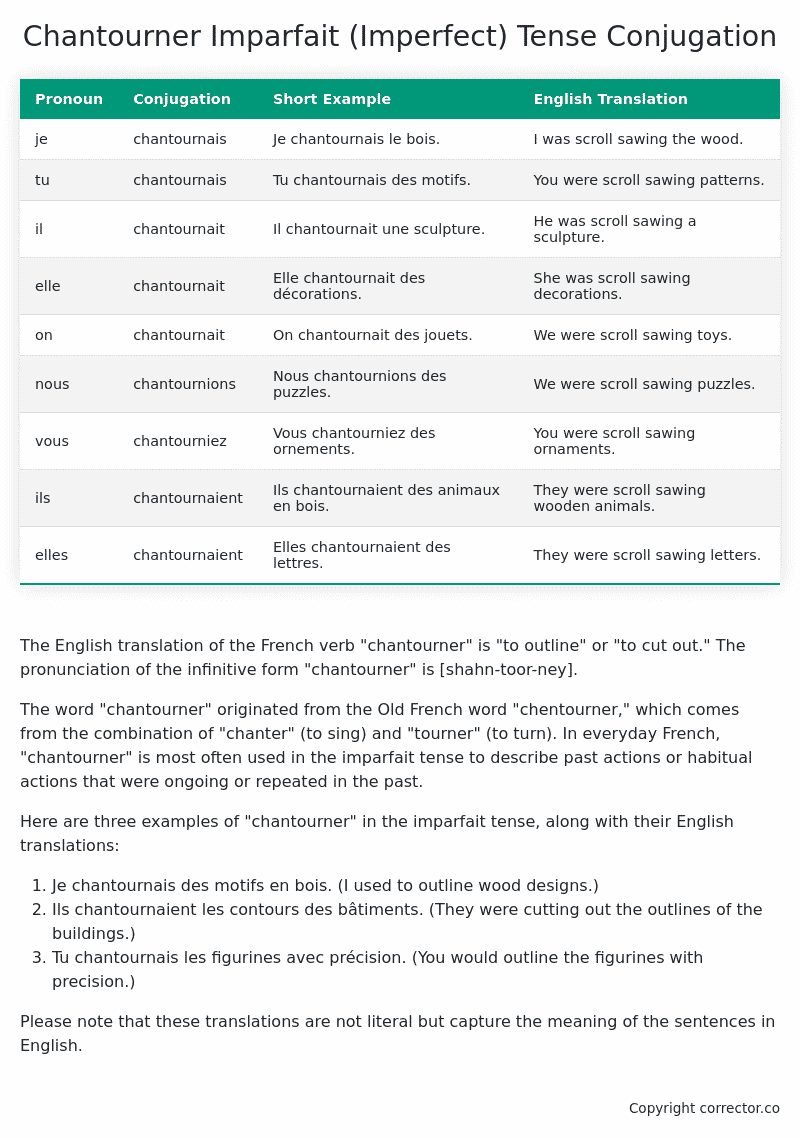Imparfait (Imperfect) Tense Conjugation of the French Verb chantourner
Introduction to the verb chantourner
The English translation of the French verb “chantourner” is “to outline” or “to cut out.” The pronunciation of the infinitive form “chantourner” is [shahn-toor-ney].
The word “chantourner” originated from the Old French word “chentourner,” which comes from the combination of “chanter” (to sing) and “tourner” (to turn). In everyday French, “chantourner” is most often used in the imparfait tense to describe past actions or habitual actions that were ongoing or repeated in the past.
Here are three examples of “chantourner” in the imparfait tense, along with their English translations:
- Je chantournais des motifs en bois. (I used to outline wood designs.)
- Ils chantournaient les contours des bâtiments. (They were cutting out the outlines of the buildings.)
- Tu chantournais les figurines avec précision. (You would outline the figurines with precision.)
Please note that these translations are not literal but capture the meaning of the sentences in English.
Table of the Imparfait (Imperfect) Tense Conjugation of chantourner
| Pronoun | Conjugation | Short Example | English Translation |
|---|---|---|---|
| je | chantournais | Je chantournais le bois. | I was scroll sawing the wood. |
| tu | chantournais | Tu chantournais des motifs. | You were scroll sawing patterns. |
| il | chantournait | Il chantournait une sculpture. | He was scroll sawing a sculpture. |
| elle | chantournait | Elle chantournait des décorations. | She was scroll sawing decorations. |
| on | chantournait | On chantournait des jouets. | We were scroll sawing toys. |
| nous | chantournions | Nous chantournions des puzzles. | We were scroll sawing puzzles. |
| vous | chantourniez | Vous chantourniez des ornements. | You were scroll sawing ornaments. |
| ils | chantournaient | Ils chantournaient des animaux en bois. | They were scroll sawing wooden animals. |
| elles | chantournaient | Elles chantournaient des lettres. | They were scroll sawing letters. |
Other Conjugations for Chantourner.
Le Present (Present Tense) Conjugation of the French Verb chantourner
Imparfait (Imperfect) Tense Conjugation of the French Verb chantourner (You’re reading it right now!)
Passé Simple (Simple Past) Tense Conjugation of the French Verb chantourner
Passé Composé (Present Perfect) Tense Conjugation of the French Verb chantourner
Futur Simple (Simple Future) Tense Conjugation of the French Verb chantourner
Futur Proche (Near Future) Tense Conjugation of the French Verb chantourner
Plus-que-parfait (Pluperfect) Tense Conjugation of the French Verb chantourner
Passé Antérieur (Past Anterior) Tense Conjugation of the French Verb chantourner
Futur Antérieur (Future Anterior) Tense Conjugation of the French Verb chantourner
Subjonctif Présent (Subjunctive Present) Tense Conjugation of the French Verb chantourner
Subjonctif Passé (Subjunctive Past) Tense Conjugation of the French Verb chantourner
Subjonctif Imparfait (Subjunctive Imperfect) Tense Conjugation of the French Verb chantourner
Conditionnel Présent (Conditional Present) Tense Conjugation of the French Verb chantourner
Conditionnel Passé (Conditional Past) Tense Conjugation of the French Verb chantourner
Conditionnel Passé II (Conditional Past II) Tense Conjugation of the French Verb chantourner
L’impératif Présent (Imperative Present) Tense Conjugation of the French Verb chantourner
L’impératif Passé (Imperative Past) Tense Conjugation of the French Verb chantourner
L’infinitif Présent (Infinitive Present) Tense Conjugation of the French Verb chantourner
L’infinitif Passé (Infinitive Past) Tense Conjugation of the French Verb chantourner
Le Participe Présent (Present Participle) Tense Conjugation of the French Verb chantourner
Le Participe Passé (Past Participle) Tense Conjugation of the French Verb chantourner
Struggling with French verbs or the language in general? Why not use our free French Grammar Checker – no registration required!
Get a FREE Download Study Sheet of this Conjugation 🔥
Simply right click the image below, click “save image” and get your free reference for the chantourner imparfait tense conjugation!

Chantourner – About the French Imparfait Tense
NOTE: To take a deep dive into all the French tenses then see our article on Mastering French Tense Conjugation.
Formation of the Imparfait Tense
For regular -er verbs:
For regular -ir verbs
For regular -re verbs
Common Everyday Usage Patterns
Description of Past Habits
Background Information
Mental and Emotional States
It’s employed to express emotions, thoughts, or physical sensations in the past. For example: “J’étais content quand il est arrivé.” (I was happy when he arrived.)
Ongoing Actions
Points to Note About the Imparfait Tense
Passé Composé vs. Imparfait
Conditional
Si Clauses
Narration
I hope you enjoyed this article on the verb chantourner. Still in a learning mood? Check out another TOTALLY random French verb imparfait conjugation!


